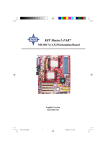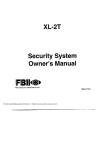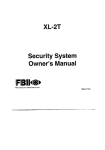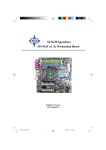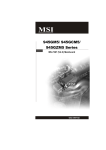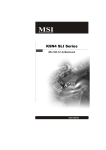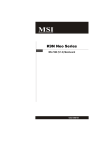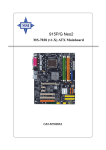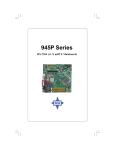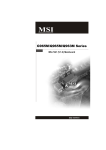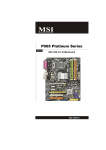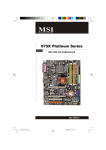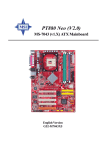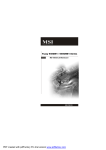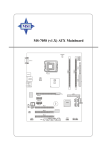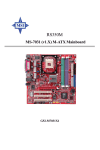Download MSI MS-7236 (V2.X) Mainboard G52-72361X2 User`s manual
Transcript
945P Neo3 Series MS-7236 (V2.X) Mainboard G52-72361X2 i Copyright Notice T he material in this doc ument is the intellec tual property of M ICRO-STAR INTERNATIONAL. We take every care in the preparation of this document, but no guarantee is given as to the correctness of its contents. Our products are under continual improvement and we reserve the right to make changes without notice. Trademarks All trademarks are the properties of their respective owners. NVIDIA, the NVIDIA logo, DualNet, and nForce are registered trademarks or trademarks of NVIDIA Corporation in the United States and/or other countries. AMD, Athlon™, Athlon™ XP, Thoroughbred™, and Duron™ are registered trademarks of AMD Corporation. Intel® and Pentium® are registered trademarks of Intel Corporation. PS/2 and OS ® /2 are registered trademarks of International Business Machines Corporation. W indows ® 95/98/2000/NT/XP are registered trademarks of Microsoft Corporation. Netware® is a registered trademark of Novell, Inc. Award® is a registered trademark of Phoenix Technologies Ltd. AMI® is a registered trademark of American Megatrends Inc. Revision History Revision Revision History Date V2.X First release August 2006 Technical Support If a problem arises with your system and no solution can be obtained from the user’s manual, please contact your place of purchase or local distributor. Alternatively, please try the following help resources for further guidance. Visit the MSI website for FAQ, technical guide, BIOS updates, driver updates, and other information: http://www.msi.com.tw/program/service/faq/ faq/esc_faq_list.php Contact our technical staff at: http://support.msi.com.tw ii Safety Instructions 1. Always read the safety instructions carefully. 2. Keep this User’s Manual for future reference. 3. Keep this equipment away from humidity. 4. Lay this equipment on a reliable flat surface before setting it up. 5. The openings on the enclosure are for air convection hence protects the equipment from overheating. DO NOT COVER THE OPENINGS. 6. Make sure the voltage of the power source and adjust properly 110/220V before connecting the equipment to the power inlet. Rating: 100-127/200-240V~, 4/2A, 60/50Hz. 7. Place the power cord such a way that people can not step on it. Do not place anything over the power cord. 8. Always Unplug the Power Cord before inserting any add-on card or module. 9. All cautions and warnings on the equipment should be noted. 10. Never pour any liquid into the opening that could damage or cause electrical shock. 11. If any of the following situations arises, get the equipment checked by service personnel: † † † † The power cord or plug is damaged. Liquid has penetrated into the equipment. The equipment has been exposed to moisture. The equipment does not work well or you can not get it work according to User’s Manual. † The equipment has dropped and damaged. † The equipment has obvious sign of breakage. 12. DO NOT LEAVE THIS EQUIPMENT IN AN ENVIRONMENT UNCONDITIONED, STORAGE TEMPERATURE ABOVE 600 C (1400F), IT MAY DAMAGE THE EQUIPMENT. CAUT ION: Danger of expl os i on if bat ter y i s i nc orrec tl y r epl ac ed. Replac e only with the same or equivalent type rec ommended by the manufacturer. iii FCC-B Radio Frequency Interference Statement T hi s equipment has b een tested and found to comply with the limits for a Class B digital device, pursuant to Part 15 of the FCC Rules. These limits are designed to provide reasonable protection against harmful interference in a residential installation. This equipment generates, uses and can radiate radio frequency energy and, if not installed and used in accordance with the instructions, may cause harmful interference to radio communications. However, there is no guarantee that interference will not occur in a particular installation. If this equipment does cause harmful interference to radio or television reception, which can be determined by turning the equipment off and on, the user is encouraged to try to correct the interference by one or more of the measures listed below. † Reorient or relocate the receiving antenna. † Increase the separation between the equipment and receiver. † Connect the equipment into an outlet on a circuit different from that to which the receiver is connected. † Consult the dealer or an experienced radio/television technician for help. Notice 1 The changes or modifications not expressly approved by the party responsible for compliance could void the user’s authority to operate the equipment. Notice 2 Shielded interface cables and A.C. power cord, if any, must be used in order to comply with the emission limits. VOIR LA NOTICE D’INSTALLATION AVANT DE RACCORDER AU RESEAU. Micro-Star International MS-7236 This device complies with Part 15 of the FCC Rules. Operation is subject to the following two conditions: (1) this device may not cause harmful interference, and (2) this device must accept any interference received, including interference that may cause undesired operation. iv WEEE (Waste Electrical and Electronic Equipment) Statement v vi vii CONTENTS Copyright Notice ................................................................................................................ ii Trademarks ....................................................................................................................... ii Revision History ................................................................................................................ ii Technical Support ............................................................................................................. ii Safety Instructions .......................................................................................................... iii FCC-B Radio Frequency Interference Statement ......................................................... iv WEEE Statement ............................................................................................................... v Chapter 1. Getting Started ..................................................................................... 1-1 Mainboard Specifications .................................................................................... 1-2 Mainboard Layout ................................................................................................ 1-4 Packing Checklist .................................................................................................. 1-5 Core Center .......................................................................................................... 1-6 Left-wing: Current system status ............................................................... 1-7 Right-wing: PC hardware status during real time operation ..................... 1-7 Chapter 2. Hardware Setup ................................................................................... 2-1 Quick Components Guide .................................................................................... 2-2 Central Processing Unit: CPU ............................................................................... 2-3 Introduction to LGA 775 CPU ....................................................................... 2-3 CPU & Cooler Installation .............................................................................. 2-4 Memory ................................................................................................................. 2-7 Memory Module Population Rules ................................................................ 2-7 Installing DDR2 Modules ............................................................................... 2-8 Power Supply ...................................................................................................... 2-9 ATX 24-Pin Power Connector: ATX1 .......................................................... 2-9 ATX 12V Power Connector: PWRCONN1 ................................................... 2-9 Back Panel .......................................................................................................... 2-10 Mouse/Keyboard Connector ..................................................................... 2-10 Serial Port Connector: COM Port ............................................................... 2-10 USB Connectors ......................................................................................... 2-11 LAN (RJ-45) Jack ........................................................................................ 2-11 Audio Port Connectors .............................................................................. 2-12 Parallel Port Connector: LPT1 .................................................................... 2-13 Connectors ......................................................................................................... 2-14 Floppy Disk Drive Connector: FDD1 ........................................................... 2-14 Fan Power Connectors: CPUFAN1/SYSFAN1/PWRFAN1 ........................ 2-14 Hard Disk Connector: IDE1 ......................................................................... 2-15 Serial ATAII Connectors controlled by Intel ICH7: SATA1~SATA4 ........... 2-16 CD-In Connector: JCD1 .............................................................................. 2-17 viii Front Panel Connectors: JFP1 / JFP2 ........................................................ 2-17 Front USB Connectors: JUSB1 / JUSB2 ................................................... 2-18 Front Panel Audio Connector: JAUD1 ....................................................... 2-18 IrDA Infrared Module Header: JIR1 ............................................................ 2-19 Serial Port Connector: JCOM1 ................................................................... 2-19 Chassis Intrusion Switch Connector: JCI1 ................................................ 2-19 SPDIF-Out Connector: JSPD1 .................................................................... 2-20 Jumpers .............................................................................................................. 2-21 Clear CMOS Jumper: JBAT1 ...................................................................... 2-21 Slots .................................................................................................................... 2-22 PCI Express Slots (optional) ...................................................................... 2-22 PCI (Peripheral Component Interconnect) Slots ........................................ 2-22 PCI Interrupt Request Routing .................................................................... 2-22 Chapter 3. BIOS Setup ............................................................................................. 3-1 Entering Setup ...................................................................................................... 3-2 Control Keys ................................................................................................. 3-3 Getting Help .................................................................................................. 3-3 General Help ................................................................................................. 3-3 The Main Menu ..................................................................................................... 3-4 Standard CMOS Features ................................................................................... 3-6 Advanced BIOS Features ................................................................................. 3-10 Advanced Chipset Features ............................................................................. 3-14 Integrated Peripherals ........................................................................................ 3-16 Power Management Features ........................................................................... 3-20 PCI/PNP Resource Management ........................................................................ 3-23 H/W Monitor ........................................................................................................ 3-26 Cell Menu ............................................................................................................ 3-28 Load Fail-Safe/Optimized Defaults .................................................................... 3-31 BIOS Setting Password ..................................................................................... 3-32 Appendix A. Realtek ALC850 ................................................................................. A-1 Installing the Audio Driver .................................................................................... A-2 Installation for Windows 98SE/ME/2000/XP ............................................... A-2 Software Configuration ....................................................................................... A-4 Sound Effect ................................................................................................ A-5 Speaker Configuration ................................................................................. A-7 3D Audio Demo .............................................................................................. A-9 General ....................................................................................................... A-10 SPDIF........................................................................................................... A-11 Hardware Configuration .................................................................................... A-12 Using 2-, 4-, 6- & 8- Channel Audio Function ................................................... A-12 ix Getting Started Chapter 1 Getting Started Thank you for choosing the 945P Neo3 (MS-7236) V2. X ATX mainboard. The 945P Neo3 mainboard is based on Intel® 945P and Intel® ICH7 chipset for optimal system effic iency. Designed to fit the advanc ed Intel ® Pent iu m 4 L G A 775 p roc es s or, th e 945 P Neo3 mainboard delivers a high performance and professional desktop platform solution. 1-1 M S-7236 M ainboard Mainboard Specifications Processor Support - Supports Intel ® Core 2 Duo / Pentium D / Pentium 4 LGA775 processors in LGA775 package - Supports 2004 Perform ance EMB CPU VR Design - Supports 3/4 pin CPU Fan Pin-Header with Fan Speed Control - Supports Intel Hyper-Threading Technology (For the latest information about CPU, please visit http://www.msi. com.tw/program/products/mainboard/mbd/pro_mbd_cpu_support.php) Supported FSB - 533 / 800 / 1066 MHz Chipset - North Bridge: Intel ® 945P chipset - South Bridge: Intel ® ICH7 chipset Memory Support - DDRII 667/533/400 SDRAM (4GB Max) - 4 DDRII DIMMs (240pin / 1.8V) LAN (Optional) - 10/100 Mb/s supported by Realtek RTL8100C - 10/100/1000 Mb/s supported by Realtek RTL8110SC - Com pliane with PCI 2.2 - Supports ACPI Power Managem ent Audio - Chip integrated by Realtek® ALC850 - Flexible 8-channel audio with jack sensing - Compliance with AC97 V2.3 spec - AC97 link controller integrated in ICH7 - Meet PC2001 audio performance requirem ent IDE - 1 Ultra DMA 66/100 IDE controller integrated in ICH7 - Supports PIO, Bus Master operation m odes - Can connect up to four Ultra ATA drives SATA - SATAII controller integrated in ICH7 - Supports 4 SATA II Device - Supports storage and data transfers at up to 300MB/s Floppy - 1 floppy port - Supports 1 FDD with 360K, 720K, 1.2M, 1.44M and 2.88Mbytes 1-2 Getting Started Connectors Back panel - 1 PS/2 m ouse port - 1 PS/2 keyboard port - 1 serial port - 1 parallel port supports SPP/EPP/ECP m ode - 4 USB 2.0 Ports - 1 RJ-45 LAN jack - 6 flexible audio jacks (Line-In / Line-Out / MIC-In / Rear Speaker-Out / Center-Subwoofer Speaker-Out/ Surround-Out) On-Board Pinheaders - 2 USB 2.0 pinheaders - 1 serial pinheader - 1 CD-In pinheader - 1 SPDIF-Out pinheader (for HDMI function) Slots - One PCI Express x16 slot - One PCI Express x1 slot - Four 32-bit v2.3 Master PCI bus slots - Support 3.3v/5v PCI bus interface Form Factor - ATX (30.5cm X 22.5 cm) Mounting - 6 mounting holes 1-3 M S-7236 M ainboard DIMM4 DIMM3 CPUFAN1 DIMM2 Top : mouse Bottom: keyboard DIMM1 Mainboard Layout Top : Parallel Port Bottom: COM portA USB ports PWRCONN1 Top: LAN Jack Bottom: USB ports PWRFAN1 ATX1 T:Line-In M: Line-Out B:Mic T:R S- Out M:CS- Out B:SS- Out SYSFAN1 IDE1 PCI_E1 RTL8110SC JIR1 Intel 945P PCI_E2 JCI1 PCI1 Winbond W83627DHG FDD1 JUSB2 JUSB1 945P Neo3 Series (MS-7236) V2.X ATX Mainboard 1-4 SATA4 SATA3 SATA1 BATT + PCI4 BIOS ALC850 JAUD1 JBAT1 PCI3 JCOM1 JSPD1 CD_IN1 Intel ICH7 SATA2 PCI2 JFP1 JFP2 Getting Started Packing Checklist MSI mainboard MSI Driver/Utility CD SATA Cable x 1 (Optional) Standard Cable for Power Cable IDE Devices (Optional) User’s Guide D-Bracket 2 (Optional) Back IO Shield * These pictures are for yuour reference only. Your packing contents may vary depending on the model you purchased. 1-5 M S-7236 M ainboard Core Center Click on the Core Center icon in the main menu and the Core Center program will be enabled. CoreCenter is just like your PC doctor that can detect, view and adjust the PC hardware and system status during real time operation. In the left side it shows the current system status including the Vcore, 3.3V, +5V and 12V. In the right side it shows the current PC hardware status such as the CPU & system temperatures and all fans speeds. W hen you click the red triangles in the left and right sides, two sub-menus will open for users to adjust the thresholds of system to send out the warning messages. 1-6 Getting Started Left-wing: Current system status In the left sub-menu, you can configure the settings of FSB, Vcore, Memory Voltage and AGP Voltage by clicking the radio button next to each item and make it available (the radio button will be lighted as yellow when selected), use the “+” and “-” buttons to adjust, then click “OK” to apply the changes. Then you can click “Save” to save the values you just configured. Also you may click “Auto” to start testing the maximum CPU overclocking value. The CPU FSB will automatically increase the testing value until the PC reboots. Or you may click “Default” to restore the default values. Right-wing: PC hardware status during real time operation In the right sub-menu, here you can configure the PC hardware status such as CPU & system temperatures and fan speeds. You may use the scroll bars to adjust each item, then click “OK” to apply the changes. The values you set for the temperatures are the maximum thresholds for the system for warnings, and the value for fan speeds are the minimum thresholds. 1-7 Hardware Setup Chapter 2 Hardware Setup This chapter provides you with the information about hardware setup procedures. W hile doing the installation, be careful in holding the components and follow the installation procedures. For some components, if you install in the wrong orientation, the components will not work properly. Use a grounded wrist strap before handling computer c omp onent s . St at ic el ec t ri c it y may d am age t he components. ONLY FOR SERVICE PERSONEL Always unplug the power cord before inserting any add-on card or module. 2-1 M S-7236 M ainboard Quick Components Guide PWRCONN1 p.2-9 ATX1 CPU CPUFAN1 p.2-9 p.2-3 p.2-14 Back Panel p.2-10 DIMM1-4, p.2-7 PWRFAN1 SYSFAN1, p.2-14 PCI-E Slots p.2-22 JIR1, p.2-19 IDE1, p.2-15 JCI1, p.2-20 JCOM1, p.2-19 SATA1-4, p.2-16 JCD1, p.2-17 JBAT1, p.2-21 JAUD1, p.2-18 JSPD1, FDD1, PCI Slots, p.2-20 p.2-14 p.2-22 JUSB1-2, JFP1-2, p.2-18 p.2-17 945P Neo3 Series (MS-7236) V2.X ATX Mainboard 2-2 Hardware Setup Central Processing Unit: CPU The mainboard supports Intel® Pentium 4 Series processor. The mainboard uses a CPU socket called LGA775. When you are installing the CPU, make sure to install the cooler to prevent overheating. If you do not have the CPU cooler, contact your dealer to purchase and install them before turning on the computer. (For the latest information about CPU, please visit http://www.msi.com.tw/program/ products/mainboard/mbd/pro_mbd_cpu_support.php) Important Overheating Overheating will seriously damage the CPU and system, always make sure the cooling fan c an work properly to protec t the CPU from overheating. Replacing the CPU While replacing the CPU, always turn off the ATX power supply or unplug the power supply’s power cord from grounded outlet first to ensure the safety of CPU. Overclocking This motherboard is designed to support overclocking. However, please make sure your components are able to tolerate such abnormal setting, while doing overclocking. Any attempt to operate beyond product specifications is not recommended. We do not guarantee the damages or risks caused by inadequate operation or beyond product specifications. Introduction to LGA 775 CPU The pin-pad side of LGA 775 CPU. The surface of LGA 775 CPU. Remember to apply some silicone heat transfer c o m p ou n d on i t f o r b et t e r h e at dispersion. Alignment Key Alignment Key Yellow triangle is the Pin 1 indicator Yellow triangle is the Pin 1 indicator 2-3 M S-7236 M ainboard CPU & Cooler Installation W hen you are installing the CPU, make sure the CPU has a cooler attached on the top to prevent overheating. If you do not have the cooler, contact your dealer to purchase and install them before turning on the computer. Meanwhile, do not forget to apply some silicon heat transfer compound on CPU before installing the heat sink/cooler fan for better heat dispersion. Follow the steps below to install the CPU & cooler correctly. W rong installation will cause the damage of your CPU & mainboard. 1. The CPU socket has a plastic cap on it to protect the contact from damage. Before you install the CPU, always cover it to protect the socket pin. 2. Remove the cap from lever hinge side (as the arrow shows). 3. The pins of socket reveal. 4. Open the load lever. 2-4 Hardware Setup 5. Lift the load lever up and open the load plate. 6. After confirming the CPU direction for correct mating, put down the CPU in the socket housing frame. Be sure to grasp on the edge of the CPU base. Note that the alignment keys are matched. alignment key 7. Visually ins pect if the CPU is seated well into the socket. If not, take out the CPU with pure vertical motion and reinstall. 8. Cover the load plate onto the package. Important 1. Confirm if your CPU cooler is firmly installed before turning on your system. 2. Do not touch the CPU socket pins to avoid damaging. 3. The availability of the CPU land side cover depends on your CPU packing. 2-5 M S-7236 M ainboard 9. Press down the load lever lightly onto the load plate, and then secure the lever with the hook under retention tab. 10. Align the holes on the mainboard with the heatsink. Push down the c ooler u nti l i ts f ou r c lip s g et wedged int o t he holes of t he mainboard. 11. Press the four hooks down to fasten the cooler. Then rotate the locking switch (refer to the correct direction marked on it) to lock the hooks. 12. Turn over the mainboard to confirm that the clip-ends are correctly inserted. locking switch Important 1. Check the information in H/W Monitor in BIOS (Chapter 3) for the CPU temperature. 2. Whenever CPU is not installed, always protect your CPU socket pin with the plastic cap covered (shown in step 1) to avoid damaging. 2-6 Hardware Setup Memory The mainboard provides 4 slots for 240-pin DDR II 667/533/400 DIMM, which supports the memory size up to 4GB. Since DDR2 modules are not interchangeable with DDR I and the DDR II standard is not backward compatible, you should always install DDR II memory module in the DDR II slot (DIMM1~DIMM4). Otherwise, you are not able to boot up your system and your mainboard might be damaged. (For the updated supporting memory modules, please visit http://www.msi.com.tw/program/products/ mainboard/mbd/pro_mbd_trp_list.php) DIMM1,2 and DIMM3,4 (from left (Green) to right(Orange)) Channel A (DIMM1 & DIMM2): Green Channel B (DIMM3 & DIMM4): Orange Memory Module Population Rules Install at least one DIMM module on the slots. Each channel supports up to a maximum size of 2GB and maximum 2 bank memory modules. Important 1. Each DIMM can work respectively for single-channel DDR, while both channels (in different color) populated with same amount of memory size will work as dual-channel DDR. 2. The mainboard supports up to 2 double- side or 4 single-side memory modules. - Please select the identical memory modules to install on the dual channel, and DO NOT install three memory modules on three DIMMs, or it may cause some failure. - Always insert the memory modules into the GREEN slots first, and it is strongly recommended not to insert the memory modules into the ORANGE slots while the GREEN slots are left empty. - This mainboard DO NOT support the memory module installed with more than 18 pieces of IC (integrated circuit). 2-7 M S-7236 M ainboard Installing DDR II Modules 1.The DDR II DIMM has only one notch on the center of module. The module will only fit in the right orientation. 2.Insert the DIMM memory module vertically into the DIMM slot. Then push it in until the golden finger on the memory module is deeply inserted in the socket. 3.The plastic clip at each side of the DIMM slot will automatically close. Volt Notch Important You can barely see the golden finger if the module is properly inserted in the socket. 2-8 Hardware Setup Power Supply The mainboard supports ATX power supply for the power system. Before inserting the power supply connector, always make sure that all components are installed properly to ensure that no damage will be caused. ATX 24-Pin Power Connector: ATX1 This connector allows you to connect an ATX 24-pin power supply. To connect the ATX 24-pin power supply, make sure the plug of the power supply is inserted in the proper orientation and the pins are aligned. Then push down the power supply firmly into the connector. Pin Definition 1 13 12 24 PIN SIGNAL PIN SIGNAL 1 +3.3V 13 +3.3V 2 3 +3.3V GND 14 15 -12V GND 4 5 +5V GND 16 17 PS-ON# GND 6 7 +5V GND 18 19 GND GND 8 9 PWR OK 5VSB 20 21 Res +5V 10 11 +12V +12V 22 23 +5V +5V 12 +3.3V 24 GND ATX1 ATX 12V Power Connector: PWRCONN1 This 12V power connector is used to provide power to the CPU. 4 3 2 1 PWRCONN1 Pin Definition PIN SIGNAL 1 2 GND GND 3 4 12V 12V Important 1. These two connectors connect to the ATX power supply and have to work together to ensure stable operation of the mainboard. 2. Power supply of 350 watts (and above) is highly recommended for system stability. 3. ATX 12V power connection should be greater than 18A. 2-9 M S-7236 M ainboard Back Panel The back panel provides the following connectors: M ou se Parallel LAN L-In RS-Out L-Out CS-Out Keyboard COM Port USB Ports Mic Surround Out Mouse/Keyboard Connector The mainboard provides a standard PS/2® mouse/keyboard mini DIN connector for attaching a PS/2® mouse/keyboard. You can plug a PS/2® mouse/keyboard directly into this connector. The connector location and pin assignments are as follows: Pin Definition 6 5 3 4 1 2 PS/2 Mouse / Keyboard (6-pin Female) PIN SIGNAL DESCRIPTION 1 Mouse/Keyboard Data Mouse/Keyboard data 2 3 NC GND No connection Ground 4 5 VCC Mouse/KeyboardClock +5V Mouse/Keyboard clock 6 NC No connection Serial Port Connector: COM Port The mainboard offers one 9-pin male DIN connector COM Port. It’s a 16550A high speed communication port that send/receive/ 16 bytes FIFOs. You can attach a serial mouse or other serial device directly to it. Pin Definition 1 2 6 3 7 4 8 5 9 9-Pin Male DIN Connector COM Port 2-10 PIN SIGNAL DESCRIPTION 1 DCD Data Carry Detect 2 3 SIN SOUT Serial In or Receive Data Serial Out or Transmit Data 4 5 DTR GND Data Terminal Ready) Ground 6 7 DSR RTS Data Set Ready Request To Send 8 9 CTS RI Clear To Send Ring Indicate Hardware Setup USB Connectors The mainboard provides an OHCI (Open Host Controller Interface) Universal Serial Bus root for attaching USB devices such as keyboard, mouse or other USB-compatible devices. You can plug the USB device directly into the connector. Port Description 1 5 2 6 3 7 4 8 USB Ports PIN SIGNAL DESCRIPTION 1 VCC +5V 2 3 -Data 0 +Data0 Negative Data Channel 0 Positive Data Channel 0 4 5 GND VCC Ground +5V 6 7 -Data 1 +Data 1 Negative Data Channel 1 Positive Data Channel 1 8 GND Ground LAN (RJ-45) Jack (1000Mbps is optional) The mainboard provides 1 standard RJ-45 jack for connection to single Local Area Network (LAN). This LAN enables data to be transferred at 1000Mbps, 100Mbps or 10Mbps. You can connect a network cable to it. Pin Definition RJ-45 LAN Jack PIN SIGNAL DESCRIPTION 1 D0P Differential Pair 0+ 2 D0N Differential Pair 0- 3 D1P Differential Pair 1+ 4 D2P Differential Pair 2+ 5 D2N Differential Pair 2- 6 D1N Differential Pair 1- 7 D3P Differential Pair 3+ 8 D3N Differential Pair 3- 2-11 M S-7236 M ainboard Audio Port Connectors The left 3 audio jacks are for 2-channel mode for stereo speaker output: Line Out is a connector for Speakers or Headphones. Line In is used for external CD player, Tape player, or other audio devices. Mic is a connector for microphones. However, there is an advanced audio application provided by Realtek ALC850 to offer support for 7.1-channel audio operation and can turn rear audio connectors from 2-channel to 4-/5.1-/7.1- channel audio. Line In / Line Out (Surround R/L) (in 7.1 CH) Line Out (Front R/L) M IC Rear Speaker Out (in 7.1CH / 5.1CH) Center/Subwoofer Speaker Out ( in 7.1CH / 5.1CH) Surround-Out Important For the advanced functions of the audio codec, please refer to the chapter Realtek ALC850 Audio for details. 2-12 Hardware Setup Parallel Port Connector: LPT1 The mainboard provides a 25-pin female centronic connector as LPT. A parallel port is a standard printer port that supports Enhanced Parallel Port (EPP) and Extended Capabilities Parallel Port (ECP) mode. 13 1 14 25 Pin Definition PIN SIGNAL DESCRIPTION 1 2 STROBE DATA0 Strobe Data0 3 4 DATA1 DATA2 Data1 Data2 5 6 DATA3 DATA4 Data3 Data4 7 8 DATA5 DATA6 Data5 Data6 9 10 DATA7 ACK# Data7 Acknowledge 11 12 BUSY PE Busy PaperEnd 13 14 SELECT AUTO FEED# Select AutomaticFeed 15 16 ERR# INIT# Error Initialize Printer 17 18 SLIN# GND Select In Ground 19 20 GND GND Ground Ground 21 22 GND GND Ground Ground 23 24 GND GND Ground Ground 25 GND Ground 2-13 M S-7236 M ainboard Connectors . The mainboard provides connectors to connect to FDD, IDE HDD, case, LAN, and USB Ports. Floppy Disk Drive Connector: FDD1 The mainboard provides a standard floppy disk drive connector that supports 360K, 720K, 1.2M, 1.44M and 2.88M floppy disk types. FDD1 Fan Power Connectors: CPUFAN1/SYSFAN1/PWRFAN1 The CPUFAN1 (processor fan), SYSFAN1 and PW RFAN1 support system cooling fan with +12V. It supports four/three-pin head connector. W hen connecting the wire to the connectors, always take note that the red wire is the positive and should be connected to the +12V, the black wire is Ground and should be connected to GND. If the mainboard has a System Hardware Monitor chipset on-board, you must use a specially designed fan with speed sensor to take advantage of the CPU fan control. GND +12V SENSOR Control CPUFAN1 GND GND +12V Sensor +12V Sensor PW RFAN1 SYSFAN1 Important 1. Always consult the vendors for proper CPU cooling fan. 2. CPUFAN1 supports the fan control only with 4-pin CPU fan. 3. Please refer to the recommended CPU fans at Intel® official website. 2-14 Hardware Setup Hard Disk Connector: IDE1 The mainboard has 32-bit Ultra DMA 66/100 IDE controllers integrated in the chips Intel ICH7, which supports PIO & Bus Master operation modes and it can connect up to two Ultra ATA drives. IDE1 (blue) IDE1 can connect a Master and a Slave drive. You must configure second hard drive to Slave mode by setting the jumper accordingly. Important If you install two hard disks on cable, you must configure the second drive to Slave mode by setting its jumper. Refer to the hard disk documentation supplied by hard disk vendors for jumper setting instructions. 2-15 M S-7236 M ainboard Serial ATAII Connectors controlled by Intel ICH7: SATA1~SATA4 The SouthBridge of this mainboard is Intel ICH7 which supports four serial ATAII connectors SATA1~SATA4.SATA1~SATA4 are dual high-speed Serial ATAII interface ports. Each supports Serial ATAII data rates of 300MB/s. Both connectors are fully compliant with SATA 1.0 and 2.0 specifications. Each Serial ATA connector can connect to 1 hard disk device. SATA4 SATA3 SATA2 SATA1 Serial ATA cable Take off the Dust Cover and connect to the Hard Disk Devices Connect to SATA1~4 Important Please do not fold the serial ATA cable in a 90-degree angle, since this might cause the loss of data during the transmission. 2-16 Hardware Setup CD-In Connector: JCD1 The connector is for CD-ROM audio connector. L GND R JCD1 Front Panel Connectors: JFP1 / JFP2 The mainboard provides two front panel connectors for electrical connection to the front panel switches and LEDs. JFP1 is compliant with Intel® Front Panel I/O Connectivity Design Guide. Pin Definition Reset HDD Switch LED 9 10 1 2 Power Switch Power LED JFP1 PIN SIGNAL DESCRIPTION 1 HD_LED_P Hard disk LED pull-up 2 3 FP PWR/SLP HD_LED_N MSG LED pull-up Hard disk active LED 4 5 FP PWR/SLP RST_SW_N MSG LED pull-up Reset Switch low reference pull-down to GND 6 7 PWR_SW_P RST_SW_P Power Switch high reference pull-up Reset Switch high reference pull-up 8 9 PWR_SW_N RSVD_DNU Power Switch low reference pull-down to GND Reserved. Do not use. Pin Definition Power LED 7 8 1 2 PIN SIGNAL PIN SIGNAL 1 GND 2 SPK- 3 SLED 4 BUZ+ 5 7 PLED NC 6 8 BUZSPK+ Speaker JFP2 2-17 M S-7236 M ainboard Front USB Connectors: JUSB1 / JUSB2 The mainboard provides two standard USB 2.0 pin headers JUSB1 & JUSB2. USB 2. 0 technology increases data transfer rate up to a maximum throughput of 480Mbps, which is 40 times faster than USB 1.1, and is ideal for connecting high-speed USB interface peripherals such as USB HDD, digital cameras, MP3 players, printers, modems and the like. Pin Definition 9 10 1 2 PIN SIGNAL PIN SIGNAL JUSB1 / JUSB2 1 VCC 2 VCC (USB 2.0/standard spec) 3 USB0- 4 USB1- 5 USB0+ 6 USB1+ 7 GND 8 GND 9 Key 10 USBOC Important Note that the pins of VCC and GND must be connected correctly, or it may cause some damage. Front Panel Audio Connector: JAUD1 The JAUD1 front panel audio connector allows you to connect to the front panel audio and is compliant with Intel® Front Panel I/O Connectivity Design Guide. Pin Definition 1 9 2 10 JAUD1 PIN SIGNAL DESCRIPTION 1 2 AUD_MIC AUD_GND Front panel microphone input signal Ground used by analog audio circuits 3 4 AUD_MIC_BIAS AUD_VCC Microphone power Filtered +5V used by analog audio circuits 5 6 AUD_FPOUT_R AUD_RET_R Right channel audio signal to front panel Right channel audio signal return from front panel 7 8 HP_ON KEY Reserved for future use to control headphone amplifier No pin 9 10 AUD_FPOUT_L AUD_RET_L Left channel audio signal to front panel Left channel audio signal return from front panel Important If you don’t want to connect to the front audio header, pins 5 & 6, 9 9 & 10 have to be jumpered in order to have signal output directed to the rear audio ports. Otherwise, the Line-Out connector on the 10 back panel will not function. 2-18 5 6 Hardware Setup IrDA Infrared Module Header: JIR1 The connector allows you to connect to IrDA Infrared module. You must configure the setting through the BIOS setup to use the IR function. JIR1 is compliant with Intel® Front Panel I/O Connectivity Design Guide. Pin Definition 6 2 5 1 JIR1 Pin Signal 1 2 IRRX IRTX 3 4 GND VCC5 5 6 NC NC Serial Port Connector: JCOM1 The mainboard offers one 9-pin male DIN connector COM 1 (on the rear panel), and one optional serial port JCOM1. Both are 16550A high speed communication ports that send/receive 16 bytes FIFOs. You can attach a serial mouse or other serial device directly to them. Pin Definition 10 9 2 1 JCOM1 PIN SIGNAL DESCRIPTION 1 DCD Data Carry Detect 2 3 SIN SOUT Serial in or receive data Receive Data Transmit 4 5 DTR GND Serial out or transmit data Data 6 7 DSR RTS Data Set Ready Request To Send Ring 8 9 CTS RI Clear To Send Indicate 10 X X Chassis Intrusion Switch Connector: JCI1 This connector is connected to a 2-pin chassis switch. If the chassis is opened, the switch will be short. The system will record this status and show a warning message on the screen. To clear the warning, you must enter the BIOS utility and clear the record. 2 1 GND CINTRU JCI1 2-19 M S-7236 M ainboard SPDIF-Out Connector: JSPD1 (Optional, for HDMI graphics card only) This connector is used to connect SPDIF (Sony & Philips Digital Interconnect Format) interface for digital audio transmission to the HDMI graphics card. SPDF0 GND JSPD1 2-20 Hardware Setup Jumper The motherboard provides the following jumpers for you to set the computer’s function. This section will explain how to change your motherboard’s function through the use of jumpers. Clear CMOS Jumper: JBAT1 There is a CMOS RAM on board that has a power supply from external battery to keep the system configuration data. W ith the CMOS RAM, the system can automatically boot OS every time it is turned on. If you want to clear the system configuration, use the JBAT1 (Clear CMOS) Jumper to clear data. Follow the instructions below to clear the data: 1 1 3 3 Keep Data Clear Data 1 JBAT1 Important You can clear CMOS by shorting 2-3 pin while the system is off. Then return to 1-2 pin position. Avoid clearing the CMOS while the system is on; it will damage the mainboard. 2-21 M S-7236 M ainboard Slots The mainboard provides a PCI Express x16 slot, a PCI Express x1 slot and four 32-bit PCI bus slots. PCI Express Slots The PCI Express slots, as a high-bandwidth, low pin count, serial, interconnect technology, support Intel highest performance desktop platforms utilizing the Intel Pentium 4 processor with HT Technology. PCI Express architecture provides a high performance I/O infrastructure for Desktop Platforms with transfer rates starting at 2.5 Giga transfers per second over a PCI Express x1 lane for Gigabit Ethernet, TV Tuners, 1394 controllers, and general purpose I/O. Also, desktop platforms with PCI Express Architecture will be designed to deliver highest performance in video, graphics, multimedia and other sophisticated applications. Moreover, PCI Express architecture provides a high performance graphics infrastructure for Desktop Platforms doubling the capability of existing AGP 8x designs with transfer rates of 4.0 GB/s over a PCI Express x16 lane for graphics controllers. You can insert the expansion cards to meet your needs. W hen adding or removing expansion cards, make sure that you unplug the power supply first. PCI Express x16 slot PCI Express x1 slot PCI (Peripheral Component Interconnect) Slots The PCI slots allow you to insert the expansion cards to meet your needs. W hen adding or removing expansion cards, make sure that you unplug the power supply first. Meanwhile, read the documentation for the expansion card to make any necessary hardware or software settings for the expansion card, such as jumpers, switches or BIOS configuration. PCI Slots PCI Interrupt Request Routing The IRQ, acronym of interrupt request line and pronounced I-R-Q, are hardware lines over which devices can send interrupt signals to the microprocessor. The PCI IRQ pins are typically connected to the PCI bus INT A# ~ INT D# pins as follows: Order 1 Order 2 Order 3 Order 4 PCI Slot 1 INT A# INT B# INT C# INT D# PCI Slot 2 INT B# INT C# INT D# INT A# PCI Slot 3 INT C# INT D# INT A# INT B# PCI Slot 4 INT D# INT A# INT B# INT C# 2-22 BIOS Setup Chapter 3 BIOS Setup This chapter provides the information on the BIOS Setup program and allows you to configure the system for optimum use. You may need to run the Setup program when: An error message appears on the screen during the system booting up, and requests you to run SETUP. You want to change the default settings for customized features. 3-1 M S-7236 M ainboard Entering Setup Power on the computer and the system will start POST (Power On Self Test) process. W hen the message below appears on the screen, press <DEL> key to enter Setup. Press DEL to enter SETUP If the message disappears before you respond and you still wish to enter Setup, restart the system by turning it OFF and On or pressing the RESET button. You may also restart the system by simultaneously pressing <Ctrl>, <Alt>, and <Delete> keys. Important 1. The items under each BIOS category described in this chapter are under continuous update for better system performance. Therefore, the description may be slightly different from the latest BIOS and should be held for reference only. 2. Upon boot-up, the 1st line appearing after the memory count is the BIOS version. It is usually in the format: Important W7236IMS V1.0 060820 where: 1st digit refers to BIOS maker as A= AMI, W= AWARD, and P= PHOENIX. 2nd - 5th digit refers to the model number. 6th digit refers to the chipset as I= Intel, N= nVidia, and V= VIA. 7th - 8th digit refers to the customer as MS= all standard customers. V1.0 refers to the BIOS version. 060820 refers to the date this BIOS was released. 3-2 BIOS Setup Control Keys <↑> Move to the previous item <↓> Move to the next item <←> Move to the item in the left hand <→> Move to the item in the right hand <Enter> Select the item <Esc> Jumps to the Exit menu or returns to the main menu from a submenu <+/PU> Increase the numeric value or make changes <-/PD> Decrease the numeric value or make changes <F1> General Help <F5> Previous Values <F6> Fail-Safe Defaults <F7> Optimized Defaults <F10> Save & Exit Setup Getting Help After entering the Setup menu, the first menu you will see is the Main Menu. Main M enu The main menu lists the setup functions you can make changes to. You can use the arrow keys (↑↓) to select the item. The on-line description of the highlighted setup function is displayed at the bottom of the screen. Sub-M enu If you find a right pointer symbol (as shown in the right view) appears to the left of certain fields that means a sub-menu can be launched from this field. A sub-menu contains additional options for a field parameter. You can use arrow keys ( ↑↓ ) to highlight the field and press <Enter> to call up the sub-menu. Then you can use the control keys to enter values and move from field to field within a sub-menu. If you want to return to the main menu, just press the <Esc >. General Help <F1> The BIOS setup program provides a General Help screen. You can call up this screen from any menu by simply pressing <F1>. The Help screen lists the appropriate keys to use and the possible selections for the highlighted item. Press <Esc> to exit the Help screen. 3-3 M S-7236 M ainboard The Main Menu Once you enter AMI BIOS CMOS Setup Utility, the Main Menu will appear on the screen. Use arrow keys to move among the items and press <Enter> to enter the sub-menu. Standard CM OS Features Use this menu for basic system configurations, such as time, date etc. Advanced BIOS Features Use this menu to setup the items of Award® special enhanced features. Advanced Chipset Features Use this menu to change the values in the chipset registers and optimize your system’s performance. Integrated Peripherals Use this menu to specify your settings for integrated peripherals. Power M anagement Setup Use this menu to specify your settings for power management. 3-4 BIOS Setup PNP/PCI Configurations This entry appears if your system supports PnP/PCI. H/W M onitor This entry shows the status of your CPU, fan, warning for overall system status. Cell M enu Use this menu to specify your settings for CPU/AGP frequency/voltage control and overclocking. Load Fail-Safe Defaults Use this menu to load the default values set by the BIOS vendor for stable system performance. Load Optimized Defaults Use this menu to load the default values set by the mainboard manufacturer specifically for optimal performance of the mainboard. BIOS Setting Password Use these two menus to set the passwords for BIOS. Save Changes and Exit Save changes to CMOS and exit setup. Exit Without Saving Abandon all changes and exit setup. 3-5 M S-7236 M ainboard Standard CMOS Features The items in Standard CMOS Features Menu includes some basic setup items. Use the arrow keys to highlight the item and then use the <+> or <-> keys to select the value you want in each item. System Date (MM:DD:YY) This allows you to set the system to the date that you want (usually the current date). The format is <day> <month> <date> <year>. [day] Day of the week, from Sun to Sat, determined by BIOS. Read only. [mon th] The month from Jan. through Dec. [date] The date from 1 to 31 can be keyed by numeric function keys. [year] The year can be adjusted by users. System Time (HH:M M:SS) This allows you to set the system time that you want (usually the current time). The time format is <hour> <minute> <second>. Primary/Secondary/Third IDE Master/Slave Press <+> or <-> to select the hard disk drive type. The specification of hard disk drive will show up on the right hand according to your selection. Press <Enter> for the sub-menu of each item: 3-6 BIOS Setup System Information Press <Enter> to for the sub-menu of each item: CPU Type The item show the CPU related information of your system (read only). BIOS Version This item shows the BIOS version of your system (read only). System M emory Size This setting controls the exact memory size to the VGA card. 3-7 M S-7236 M ainboard LBA/Large M ode This item allows you to enable or disable the LBA (Logical Block Address, the logical block size in hard disk) mode. Setting options: [Auto], [Disabled]. Block (M ulti-Sector Transfer) Select Auto for a hard disk performance. PIO M ode This item allows you to enable or disable the PIO (Programmed Input/Output) mode. DM A M ode This item allows you to enable or disable the DMA (Direct Memory Access) mode. S.M.A.R.T. This allows you to activate the S.M.A.R.T. (Self-Monitoring Analysis & Reporting Technology) capability for the hard disks. S.M.A.R.T is a utility that monitors your disk status to predict hard disk failure. This gives you an opportunity to move data from a hard disk that is going to fail to a safe place before the hard disk becomes offline. Settings: [Auto], [Enabled], [Disabled]. 32Bit Data Transfer Enable 32bit to maximize the IDE hard disk data transfer rate. 3-8 BIOS Setup Floppy A This item allows you to set the type of the floppy drives installed. Available options: [Disabled], [360 KB, 51/4], [1.2 MB, 51/4], [720 KB, 3 1/2], [1.44 MB, 3 1/2], [2.88MB, 3 1/2]. Halt On The setting determines whether the system will stop if an error is detected at boot. Available options are: [No Errors] The system doesn’t stop for any detected error. [All, But Keyboard] The system doesn’t stop for a keyboard error. 3-9 M S-7236 M ainboard Advanced BIOS Features Quick Boot Setting the item to [Enabled] allows the system to boot within 5 seconds since it will skip some check items. Available options: [Enabled], [Disabled]. CPU Configuration Press <Enter> to enter the sub-menu. 3-10 BIOS Setup Max CPUID Value Limit W hen CPUID instruction is executed, newer CPU may return a value greater than 3 which causes certain problem with specific operating systems. Enabling "Max CPUID Value Limit" will limit the returned value to 3 and less to get rid of the problem. The problem is not seen with W indows series operating systems so the default is set to disabled for it. Virtualization Technology (Only for the CPU with Dual Core) Virtualization Technology will allow a platform to run multiple operating systems and applications in independent partitions. W ith virtualization, one computer system can function as multiple “virtual” systems. W ith enhancements to Intel’s various platforms, Intel Virtualization Technology can improve the robustnes s and performanc e of today’s software-only solutions .Settings: [Enabled], [Disabled]. Execute Disable Bit Execute-Disable Bit capability is a robust hardware feature, detectable using the CPUID instruction, that protects against malicious software executing code on IA-32 systems.Settings: [Enabled], [Disabled]. Hardware Prefetcher This item allows you to to enable/disable the hardware prefetcher, or in other words – hardware prefetch mechanism.Settings: [Enabled], [Disabled]. Adjacent Cache Line Prefetch This item allows you to enable/disable the adjacent cache line prefetch mode. W hen disabled, only one 64 byte line from the 128 byte sector is prefetched (which contains the requested data). W hen enabled – both lines are prefetched no matter whether they have or have not the requested data. Setting options: [Enabled], [Disabled]. Hyper-Threading Technology The processor uses Hyper-Threading technology to increase transaction rates and reduces end-user response times. The technology treats the two cores inside the processor as two logical processors that can execute instructions simultaneously. In this way, the system performance is highly improved. If you disable the function, the processor will use only one core to execute the instructions. Please disable this item if your operating system doesn’t support HT Function, or unreliability and instability may occur. 3-11 M S-7236 M ainboard Important Enabling the functionality of Hyper-Threading Technology for your computer system requires ALL of the following platform Components: * CPU: An Intel® Pentium® 4 Processor with HT Technology; * Chipset: An Intel® Chipset that supports HT Technology; * BIOS: A BIOS that supports HT Technology and has it enabled; * OS: An operating system that supports HT Technology. (For more information on Hyper-threading Technology, please visit http:/ /www.intel.com/info/hyperthreading) Full Screen LOGO Display This item enables you to show the company logo on the bootup screen. Settings are: [Enabled] Shows a still image (logo) on the full screen at boot. [Disabled] Shows the POST messages at boot. IOAPIC Function This field is used to enable or disable the APIC (Advanced Programmable Interrupt Controller). Due to compliance with PC2001 design guide, the system is able to run in APIC mode. Enabling APIC mode will expand available IRQ resources for the system. Setting options: [Enabled], [Disabled]. Boot Up Num-Lock LED This setting is to set the Num Lock status when the system is powered on. Setting to [On] will turn on the Num Lock key when the system is powered on. Setting to [Off] will allow users to use the arrow keys on the numeric keypad. Setting options: [On], [Off]. MPS Confuration This field allows you to select which MPS (Multi-Processor Specification) version to be used for the operating system. You need to select the MPS version supported by your operating system. To find out which version to use, consult the vendor of your operating system. Settings: [1.4], [1.1]. 3-12 BIOS Setup PCI Express Confuration - Active State Power-M anagement This field allows you to enable/disable PCI Express L0s and L1 link power stats. Settings: [Enabled], [Disabled]. Boot Device Priority The original IBM PCs loaded the DOS operating system from drive A (floppy disk), so IBM PC-compatible systems are designed to search for an operating system first on drive A, and then on drive C (hard disk). However, modern computers usually load the operating system from the hard drive, and may even load it from a CD-ROM drive. 3-13 M S-7236 M ainboard Advanced Chipset Features Important Change these settings only if you are familiar with the chipset. DRAM Frequency Use this field to configure the clock frequency of the installed DRAM. Setting options: [Auto], [400], [533], [667]. Configure DRAM Timing by SPD Selects whether DRAM timing is controlled by the SPD (Serial Presence Detect) EEPROM on the DRAM module. Setting to [Enabled] enables DRAM timings and the following related items to be determined by BIOS based on the configurations on the SPD. Selecting [Disabled] allows users to configure the DRAM timings and the following related items manually. Setting options: [Enabled], [Disabled]. 3-14 BIOS Setup M emory Hole In order to improve performance, certain space in memory can be reserved for ISA peripherals. This memory must be mapped into the memory space below 16MB. W hen this area is reserved, it cannot be cached. Settings: [Disabled], [15MB-16MB]. Initate Graphic Adapter This item allows you to select which graphics controller to use as the primary boot device. Setting options: [PCI/PEG], [PEG/PCI]. PEG Force X1 This setting determines whether the PCI Express x16 graphic is used. W hen setting to [Enabled], force the bandwidth frome x16 down to x1. Setting options: [Enabled] and [Disabled]. 3-15 M S-7236 M ainboard Integrated Peripherals USB Functions This setting is used to enable/disable the onboard USB host controller. Setting options: [Disabled], [Enabled]. USB 2.0 Controller Set to [Enabled] if you need to use any USB 2.0 device in the operating system that does not support or have any USB 2.0 driver installed, such as DOS and SCO Unix. Setting options: [Disabled], [Enabled]. USB Keyboard Legacy Support Select [Enabled] if your system contains a Universal Serial Bus (USB) controller and you have a USB keyboard. USB Mouse Legacy Support Select [Enabled] if you need to use a USB-interfaced mouse in the operating system. The settings are: [Enabled], [Disabled]. 3-16 BIOS Setup Onboard LAN Controller This setting allows you to enable/disable the onboard LAN controller. Setting options: [Enabled], [Disabled]. Onboard LAN Option ROM The item enables or disables the initialization of the onboard LAN Boot ROMs during bootup. Selecting [Disabled] will speed up the boot process. Setting options: [Enabled], [Disabled]. IDE Configuration Press <Enter> to enter the sub-menu: PCI IDE BusM aster This item allows you to enable/ disable the PCI IDE busmaster. Setting options: [Disabled], [Enabled]. SATA Devices Configuration Press <Enter> to enter the sub-menu and the following screen appears: 3-17 M S-7236 M ainboard ATA/IDE Configuration These 2 items allow you to select the ATA/IDE and SATA configuration. Select [Disabled] in ATA/IDE Configuration if you want to disable both ATA/IDE configuration. Select [Compatible] or [Enhanced] to use the IDE, S-ATA and PATA devices. Refer to the following tables for details. ATA/IDE Configuration (Compatible) SATA Only [SATA 1/3/2/4] PATA Pri, SATA Sec [IDE1, SATA2/4] SATA Pri, PATA Sec [SATA1/3, IDE1] PATA Only [IDE1] IO Devices Configuration Press <Enter> to enter the sub-menu and the following screen appears: Onboard Floppy Controller Select [Enabled] if your system has a floppy disk controller (FDC) installed on the system board and you wish to use it. If you install add-on FDC or the system has no floppy drive, select [Disabled] in this field. Setting options: [Enabled], [Disabled]. Serial Port1/2 Address These items specify the base I/O port addresses of the onboard Serial Port 1 . Selecting [Auto] allows BIOS to automatically determine the correct base I/O port address. Settings: [3F8/IRQ4], [2F8/IRQ3], [3E8/IRQ4], [2E8/IRQ3] and [Disabled]. Serial Port2 M ode This item allows you to select mode for Serial Port2. Setting options: [Normal], [IrDA], [ASK IR]. 3-18 BIOS Setup Parallel Port Address There is a built-in parallel port on the on-board Super I/O chipset that provides Standard, ECP, and EPP features. It has the following options: [Disabled] [3BC/IRQ7] Line Printer port 0 [278/IRQ5] Line Printer port 2 [378/IRQ7] Line Printer port 1 Parallel Port M ode [SPP] Standard Parallel Port [EPP] Enhanced Parallel Port [ECP] Extended Capability Port [ECP + EPP] Extended Capability Port + Enhanced Parallel Port To operate the onboard parallel port as Standard Parallel Port only, choose [SPP]. To operate the onboard parallel port in the EPP mode simultaneously, choose [EPP]. By choosing [ECP], the onboard parallel port will operate in ECP mode only. Choosing [ECP + EPP] will allow the onboard parallel port to support both the ECP and EPP modes simultaneously. Parallel Port IRQ This item allows you to set parallel port IRQ. Setting options: [IRQ5], [IRQ7]. 3-19 M S-7236 M ainboard Power Management Setup Important S3-related functions described in this section are available only when your BIOS supports S3 sleep mode. ACPI Function This item is to activate the ACPI (Advanced Configuration and Power Management Interface) Function. If your operating system is ACPI-aware, such as Windows 98SE/ 2000/ME/XP, select [Enabled]. Settings: [Enabled] and [Disabled]. 3-20 BIOS Setup ACPI Standby State This item specifies the power saving modes for ACPI function. If your operating system supports ACPI, such as W indows 98SE, W indows ME and W indows 2000, you can choose to enter the Standby mode in S1 (POS) or S3 (STR) fashion through the setting of this field. Options are: [S1(POS)] The S1 sleep mode is a low power state. In this state, no system context is lost (CPU or chipset) and hardware main tains all system context. [S3(STR)] The S3 sleep mode is a lower power state where the infor mation of system configuration and open applications/files is saved to main memory that remains powered while most other hardware components turn off to save energy. The informa tion stored in memory will be used to restore the system when a “wake up” event occurs. Suspend Time Out If system activity is not detected for the length of time specified in this field, all devices except CPU will be shut off. Settings: [Disabled], [1min], [2min], [4min], [8min], [10min], [20min], [30min], [40min], [50min], [60min]. Power Button M ode This feature allows users to configure the Power Button function. Settings are: [On/ Off] The power button functions as a normal power-on/-off button. [Suspend] W hen you press the power button, the computer enters the supend sleep mode, but if the button is pressed for more than four seconds, the computer is turned off. Restore on AC Power Loss This setting specifies whether your system will reboot after a power failure or interrupt occurs. Available settings are: [Power Off] Leaves the computer in the power off state. [Power On] Leaves the computer in the power on state. [Last State] Restores the system to the previous status before power failure or interrupt occurred. Wakeup Event Setup Press <Enter> to enter sub-menu and the following screen appears. 3-21 M S-7236 M ainboard USB Device WakeUp From S3 This setting allows USB device wake up the system from S3 state. Settings are: [Enable], [Disabled]. Resume By PS/2 Keyboard The setting determines whether the system will be awakened from what power saving modes when input signal of the PS/2 keyboard is detected. Specific Key for PowerOn This item is available when Resume By PS/2 Keyboard is enabled. This controls how and whether the keyboard is able to power on the system. Press [Enter], and then you must press a key for power on the system. Resume By PS/2 M ouse The setting determines whether the system will be awakened from what power saving modes when input signal of the PS/2 mouse is detected. Resume On PM E# W hen setting to [Enabled], this setting allows your system to be awakened from the power saving modes through any event on PME (Power Management Event). Setting options: [Disabled], [Enabled]. Resume By PCIE Device W hen setting to [Enabled], this setting allows your system to be awakened from the power saving modes through any event on PME (Power Management Event). Resume On RTC Alarm This is used to enable or disable the feature of booting up the system on a scheduled time/date from the S3, S4, and S5 state. Setting options: [Disabled], [Enabled]. Select [Enabled] to adjust the date & time for RTC Alarm. 3-22 BIOS Setup PCI/PNP Resource Management This section describes configuring the PCI bus system and PnP (Plug & Play) feature. PCI, or Peripheral Component Interconnect, is a system which allows I/O devices to operate at speeds nearing the speed the CPU itself uses when communicating with its special components. This section covers some very technical items and it is strongly recommended that only experienced users should make any changes to the default settings. Clear NVRAM The NVRAM (Non-volatile Random Access Memory) is where the BIOS stores resource information for both PNP and non-PNP devices in a bit string format. W hen the item is set to [Yes], the system will reset NVRAM right after the system is booted up and then set the setting of the item back to [No] automatically. Plug & Play O/S W hen set to Yes, BIOS will only initialize the PnP cards used for booting (VGA, IDE, SCSI). The rest of the cards will be initialized by the PnP operating system like W indows 98, 2000, ME or XP. W hen set to No, BIOS will initialize all the PnP cards. Select Yes if the operating system is Plug & Play. 3-23 M S-7236 M ainboard PCI Latency Timer This item controls how long each PCI device can hold the bus before another takes over. W hen set to higher values, every PCI device can conduct transactions for a longer time and thus improve the effective PCI bandwidth. For better PCI performance, you should set the item to higher values. Setting options: [32], [64], [96], [128], [160], [192], [224], [248]. PCI Slot1~4 IRQ Preference These items specify the IRQ line for each PCI slot. Setting options: [3], [4], [5], [7], [9], [10], [11], [12], [14], [15], [Auto]. Selecting [Auto] allows BIOS to automatically determine the IRQ line for each PCI slot. IRQ Resources Setup The items are adjustable only when Resources Controlled By is set to Manual. Press <Enter> and you will enter the sub-menu of the items. IRQ Resources list IRQ 3/4/5/7/9/10/11/12/14/15 for users to set each IRQ a type depending on the type of device using the IRQ. Settings are: [Available] For Plug & Play compatible devices designed for PCI bus architecture. [Reserv ed] The IRQ will be reserved for further request. 3-24 BIOS Setup DM A Resources Setup Press <Enter> and you will enter the sub-menu of the items.DMA Resources 0/1/3/5/ 6/7 for setting determine if BIOS should remove a DMA from the available DMAs passed to devices that are configurable by the system BIOS. The available DMA pool is determined by reading the NVRAM. If more DMAs must be removed from the pool, the end user can reserve the DMA. 3-25 M S-7236 M ainboard H/W Monitor This section shows the status of your CPU, fan, overall system status, etc. Monitor function is available only if there is hardware monitoring mechanism onboard. CPU Fan Failure Warning W hen enabled, the system will automatically monitor the CPU fan during boot-up. If it detects that the CPU fan is not rotating, the system will show an error message on the screen and halt the boot-up process. The function is built with CPU fan power connector (CFAN1) only and enables you to protect the CPU form possible overheating problem. If you don’t connect the CPU fan to the CPU fan power connector, we recommend disabling the feature. Chassis Intrusion The field enables or disables the feature of recording the chassis intrusion status and issuing a warning message if the chassis is once opened. To clear the warning message, set the field to [Reset]. The setting of the field will automatically return to [Enabled] later. Setting options: [Disabled], [Enabled], [Reset]. Smart Fan Target The mainboard provides the Smart Fan system which can control the fan speed automatically depending on the current temperature to keep it with in a specific range. 3-26 BIOS Setup Smart Fan Tolerance You can select a fan tolerance value here for the specific range for the “Smart Fan Target Temp. ( oC)” item. If the current temperature of the fan reaches to the maximum threshold (the temperatures set in the “Smart Fan Target Temp. ( oC)” plus the tolerance values you set here), the fan will speed up for cooling down. On the contrary, if the current temperature reaches to the minimum threshold (the set temperatures minus the tolerance value), the fan will slow down to keep the temperature stable. System/CPU Temperature, SYS/CPU/Power FAN Speed, CPU Vcore, +12V,, +5V, +5VSB, +3.3V These items display the current status of all of the monitored hardware devices/ components such as CPU voltages, temperatures and all fans’ speeds. 3-27 M S-7236 M ainboard Cell Menu The items here includes some important settings of CPU and PCI functions. Important Change these settings only if you are familiar with the chipset. Adjust DDR Voltage (V) Adjusting the DDR voltage can increase the DDR speed. Any changes made to this setting may cause a stability issue, so changing the DDR voltage for long-term purpose is NOT recommended. Adjust NB Voltage (V) NorthBridge voltage is adjustable in the field, allowing you to increase the performance of your NorthBridge when overclocking, but stability may be affected. 3-28 BIOS Setup Important The settings shown in different color in CPU Voltage, DDR Voltage and NB Voltage help to verify if your setting is proper for your system. [G ray] Default setting. [White] Safe setting. [Yellow] High performance setting. [Red] Not recommended setting and the system may be unstable. Changing CPU Voltage, DDR Voltage and NB Voltage may result in the instability of the system; therefore, it is NOT recommended to change the default setting for long-term usage. Spread Spectrum W hen the motherboard’s clock generator pulses, the extreme values (spikes) of the pulses creates EMI (Electromagnetic Interference). The Spread Spectrum function reduces the EMI generated by modulating the pulses so that the spikes of the pulses are reduced to flatter curves. If you do not have any EMI problem, leave the setting at [Disabled] for optimal system stability and performance. But if you are plagued by EMI, select the desired range for EMI reduction. Remember to disable Spread Spectrum function if you are overclocking, because even a slight jitter can introduce a temporary boost in clock speed which may just cause your overclocked processor to lock up. Adjust CPU FSB Frequency This item allows you to select the CPU Front Side Bus clock frequency (in MHz) and overclock the processor by adjusting the FSB clock to a higher frequency. Setting options: For CPU FSB200: [200]~[500] Adjust PCI Express Frequency This item allows you to select the PCI Express frequency (in MHz). Select the number between [100]~[133] for needed frequency. CPU Dynamic OverClocking Dynamic Overclocking Technology is the automatic overclocking function, included in the MSITM ’s newly developed CoreCellTM Technology. It is designed to detect the load balance of CPU while running programs, and to adjust the best CPU frequency automatically. W hen the motherboard detects CPU is running programs, it will speed up CPU automatically to make the program run smoothly and faster. W hen the CPU is temporarily suspending or staying in the low load balance, it will restore the default settings instead. Usually the Dynamic Overclocking Technology will be powered only when users' PC need to run huge amount of data like 3D games or the video process, and the CPU frequency need to be boosted up to enhance the overall performance. Setting options: 3-29 M S-7236 M ainboard [Disabled] Disable Dynamic Overclocking function. [Private] 1st level of overclocking, increasing the CPU frequency by 2%. [Sergeant] 2nd level of overclocking, increasing the CPU frequency by 3%. [Captain] 3rd level of overclocking, increasing the CPU frequency by 4%. [Colonel] 4th level of overclocking, increasing the CPU frequency by 5%. [G eneral] 5th level of overclocking, increasing the CPU frequency by 6%. [Comma nder] 6th level of overclocking, increasing the CPU frequency by 7%. Important 1. Even though the Dynamic Overclocking Technology is more stable than manual overclocking, basically, it is still risky. We suggest user to make sure that your CPU can afford to overclock regularly first. If you find the PC appears to be unstable or reboot incidentally, it's better to disable the Dynamic Overclocking or to lower the level of overclocking options. By the way, if you need to conduct overclocking manually, you also need to disable the Dynamic OverClocking first. 2. Meanwhile, there are two functions to protect user's system from crashing. - There is a safe key "Ins" in BIOS. In case the overclocking fails, you can press "Ins" key while system rebooting to restore to the BIOS defaults. - If the system incidentally reboot for four times, the BIOS will also be restored to the defaults. Auto Disable PCI Clock This item is used to auto detect the PCI slots. W hen set to [Enabled], the system will remove (turn off) clocks from empty PCI slots to minimize the electromagnetic interference (EMI). Settings: [Enabled], [Disabled]. Adjust PCI Frequency This item allows you to select the PCI frequency (in MHz). In default this value will change automatically in accordance with the setting of Adjust CPU FSB Frequency. However, you may adjust the desired fixed PCI frequency you like by using the <+> & <-> key. Setting option: [33.3]. 3-30 BIOS Setup Load Fail-Safe/Optimized Defaults The two options on the main menu allow users to restore all of the BIOS settings to the default Fail-Safe or Optimized values. The Optimized Defaults are the default values set by the mainboard manufacturer specifically for optimal performance of the mainboard. The Fail-Safe Defaults are the default values set by the BIOS vendor for stable system performance. W hen you select Load Fail-Safe Defaults, a message as below appears: Pressing Y loads the BIOS default values for the most stable, minimal system performance. W hen you select Load Optimized Defaults, a message as below appears: Pressing Y loads the default factory settings for optimal system performance. 3-31 M S-7236 M ainboard BIOS Setting Password W hen you select this function, a message as below will appear on the screen: Type the password, up to 6 characters in length, and press <Enter>. The password typed now will replace any previously set password from CMOS memory. You will be prompted to confirm the password. Retype the password and press <Enter>. You may also press <Esc> to abort the selection and not enter a password. To clear a set password, just press <Enter> when you are prompted to enter the password. A message will show up confirming the password will be disabled. Once the password is disabled, the system will boot and you can enter Setup without entering any password. W hen a password has been set, you will be prompted to enter it every time you try to enter Setup. This prevents an unauthorized person from changing any part of your system configuration. Important Important 3-32 Realtek ALC850 Audio Appendix A Realtek ALC850 Audio The Realtek ALC850 supports 8-channel audio output, including 2 Front, 2 Rear, 1 Center and 1 Subwoofer channel. It enables connection to 2, 4, 6 or 8 speakers for better surround sound effect. This section tells you how to install and use 2-, 4-, 6- or 8-channel audio function on the board. A-1 M S-7236 M ainboard Installing the Audio Driver You need to install the driver for Realtek ALC850 codec to function properly before you can get access to 2-, 4-, 6- or 8- channel audio operations. Follow the procedures described below to install the drivers for different operating systems. Installation for Windows 98SE/ME/2000/XP For W indows ® 2000, you must install W indows ® 2000 Service Pack2 or later before installing the driver. The following illustrations are based on W indows ® XP environment and could look slightly different if you install the drivers in different operating systems. 1. Insert the application CD into the CD-ROM drive. The setup screen will automatically appear. 2. Click Realtek AC97 Audio Drivers. Click here Important The AC97 Audio Configuration software utility is under continuous update to enhance audio applications. Hence, the program screens shown here in this appendix may be slightly different from the latest software utility and shall be held for reference only. A-2 Realtek ALC850 Audio 3. Click Next to install the AC’97 Audio software. Click here 4. Click Finish to restart the system. S el ec t t hi s option Click here A-3 M S-7236 M ainboard Software Configuration After installing the audio driver, you are able to use the 2-, 4-, 6- or 8- channel audio feature now. Click the audio icon from the system tray at the lower-right corner of the screen to activate the AC97 Audio Configuration. It is also available to enable the audio driver by clicking the Sound Effect M anager from the Control Panel. A-4 Realtek ALC850 Audio Sound Effect Here you can select a sound effect you like from the Environment list. You may also edit the properties for an environment as you wish by clicking the “Edit” button, then just scroll the bar in the bottom for each property to adjust. A-5 M S-7236 M ainboard You may choose the provided sound effects, and the equalizer will adjust automatically. If you like, you may also load an equalizer setting or make an new equalizer setting to save as an new one by using the “Load EQ Setting” and “Save Preset” button, click “Reset EQ Setting” button to use the default value, or click “Delete EQ Setting” button to remove a preset EQ setting. There are also other pre-set equalizer models for you to choose by clicking “Others” under the Equalizer part. Load EQ Setting Reset EQ Setting EQ Setting On/Off Save Preset Delete EQ Setting Here it provides the Karaoke function which will automatically remove human voice (lyrics) and leave melody for you to sing the song. You may use the “up arrow” and “down arrow” button to raise/lower the key, and press the lower button to remove the human voice. Raise the key Remov e the human voice A-6 Lower the key Realtek ALC850 Audio Speaker Configuration In this tab, you can easily configure your multi-channel audio function and speakers. 1. First you have to select the audio configuration below which is identical to the audio jack on your mainboard. In this model it uses Realtek ALC850 codec which supports 8-channel, therefore you should choose 8CH audio out. 2 1 3 2. Select a desired multi-channel operation here. a. Headphone for the common headphone b. 2CH Speaker for Stereo-Speaker Output c. 4CH Speaker for 4-Speaker Output d. 6CH Speaker for 5.1-Speaker Output e. 8CH Speaker for 8-Speaker Output A-7 M S-7236 M ainboard Select the speaker by clicking it to test its functionality. The one you select will light up and make testing sound. If any speaker fails to make sound, then check whether the cable is inserted firmly to the connector or replace the bad speakers with good ones. Or you may click the “Auto Test” button to test the sounds of each speaker automatically. Center Front Left Front Right Subwoof er Side Left Rear Left Side Right Rear Right 3. W hile you are testing the speakers in 8-Channel / 6-Channel Mode, if the sound coming from the center speaker and subwoofer is swapped, you should select Swap Center/Subwoofer Output to readjust these two channels. A-8 Realtek ALC850 Audio 3D Audio Demo In this tab you may adjust your 3D positional audio before playing 3D audio applications like gaming. You may also select different environment to choose the most suitable environment you like. A-9 M S-7236 M ainboard General In this tab it provides some information about this AC97 Audio Configuration utility, including Audio Driver Version, DirectX Version, Audio Controller & AC97 Codec. You may also select the language of this utility by choosing from the Language list. Also there is a selection Show icon in system tray. Switch it on and an icon will show in the system tray. Right-click on the icon and the Audio Accessories dialogue box will appear which provides several multimedia features for you to take advantage of. A-10 Realtek ALC850 Audio SPDIF In this tab it provides options about SPDIF-Out for you to configure. † No Output: W ith this option, there is no S/PDIF output signal while playing analog and digital audio. † Output digital only: W ith this option, only digital audio will be allowed to play via SPDIF out while playing analog and digital audio. † Output digital and analog: W ith this option, both digital and analog audio will be allowed to play via SPDIF out while playing analog and digital audio. A-11 M S-7236 M ainboard Hardware Setup Connecting the Speakers W hen you have set the Multi-Channel Audio Function mode properly in the software utility, connect your speakers to the correct phone jacks in accordance with the setting in software utility. n 2-Channel M ode for Stereo-Speaker Output Refer to the following diagram and caption for the function of each phone jack on the back panel when 2-Channel Mode is selected. Back Panel 1 4 2 5 3 6 1 Line In 2 Line Out (Front channels) 3 MIC 4 Line Out (Rear surround channels, but no functioning in this mode) 5 Line Out (Center and Subwoofer channel, but no functioning in this mode) 6 Line Out (Side surround channels, but no functioning in this mode) A-12 Realtek ALC850 Audio n 4-Channel M ode for 4-Speaker Output Back Panel 1 4 2 5 3 6 Description: Connect two speakers to back panel’s front-channel Line Out connector and two speakers to t he r eal- c h an n el L in e O u t connector. 4-Channel Analog Audio Output 1 Line In 2 Line Out (Front channels) 3 MIC 4 Line Out (Rear surround channels) 5 Line Out (Center and Subwoofer channel, but no functioning in this mode) 6 Line Out (Side surround channels, but no functioning in this mode) A-13 M S-7236 M ainboard n 6-Channel M ode for 6-Speaker Output Back Panel 1 2 4 5 3 6 6-Channel Analog Audio Output Description: Connect two speakers to back panel’s Line Out connector, two speakers to the rear-channel Line out connec tor and two s peaker s t o t he c ent er / subwoofer-channel Line Out connector. 1 Line In 2 Line Out (Front channels) 3 MIC 4 Line Out (Rear surround channels) 5 Line Out (Center and Subwoofer channel) 6 Line Out (Side surround channels, but no functioning in this mode) A-14 Realtek ALC850 Audio n 8-Channel M ode for 8-Speaker Output 1 4 2 5 3 6 8-Channel Analog Audio Output 1 Side Surround Out (Side channels) 2 Line Out (Front channels) 3 MIC 4 Line Out (Rear surround channels) 5 Line Out (Center and Subwoofer channel) 6 Line Out (Side channels) Description: Connect two speakers to back panel’s Line Out connector, two speakers to the rear-channel Line out connector, two speakers to the center/subwooferchannel Line Out connector and two speakers to the side-channel Line Out connector. A-15





















































































